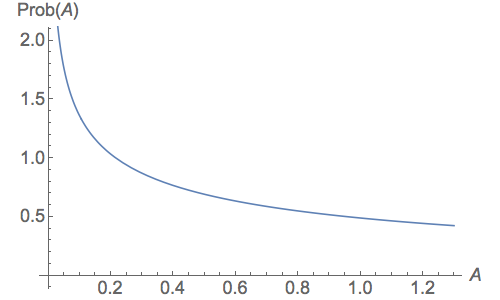Let:
$$Q(A,Y) = Y^4-2 Y^2+2 A Y \sqrt{1-Y^2}-A^2+1$$
I’m curious as to whether it’s possible to find a closed-form solution for:
$$I(A)=\int_{Y_1(A)}^{Y_2(A)} \frac{1}{\sqrt{\left(1-Y^2\right) Q(A,Y)}}\,dY\\ = \int_{\sin^{-1}(Y_1(A))}^{\sin^{-1}(Y_2(A))}\frac{2 \sqrt{2}}{\sqrt{3-8 A^2+8 A \sin (2 \theta )+4 \cos (2 \theta )+\cos (4 \theta )}}\,d\theta$$
where $0 \le A \le \frac{3 \sqrt{3}}{4}$ and $-1\le Y_1(A), Y_2(A) \le 1$ are the real zeroes of $Q(A,Y)$.
I know a re-parameterisation that makes the zeroes a bit less messy than they would be in terms of $A$. If we set:
$$A(a) = \frac{\sqrt{a^3 (a+2)^3}}{2 (a+1)}$$
with $0 \le a \le 1$ then we have:
$$Y_{1,2}(a) = \frac{a^2+a\mp (a+2) \sqrt{1-a^2}}{2 (a+1)}$$
I’m not sure if there is any way to explicitly introduce these known zeroes into the integrand, as one could do if $Q(A,Y)$ were a polynomial. I do have the following relation:
$$Q(A,Y)\,Q(-A,Y)\\ = Q(A,Y)\,Q(A,-Y)\\ =\left(Y^4-2 Y^2+2 A Y \sqrt{1-Y^2}-A^2+1\right)\left(Y^4-2 Y^2-2 A Y \sqrt{1-Y^2}-A^2+1\right)\\ = P(A,Y)\,P(A,-Y)$$ where: $$P(A,Y) = Y^4+2Y^3-2Y+A^2-1\\ P(A(a),Y)= (Y-Y_1(a))\,(Y-Y_2(a))\,\left(Y^2+(a+2)Y+\frac{a (a+2)^2+2}{2 (a+1)}\right)$$
$P(A,Y)$ has exactly the same real zeroes as $Q(A,Y)$, but has the opposite sign.
Mathematica is unable to explicitly evaluate the definite integral in either form, but it returns an indefinite integral for the trigonometric form:
$$I(A,\theta) =\\ \frac{4 \sqrt{2} \sqrt{\frac{\left(r_1-r_2\right) \left(r_3-\tan (\theta )\right)}{\left(r_1-r_3\right) \left(r_2-\tan (\theta )\right)}} \left(r_1 \cos (\theta )-\sin (\theta )\right) \left(r_4 \cos (\theta )-\sin (\theta )\right) \times \\F\left(\sin ^{-1}\left(\sqrt{\frac{\left(r_2-r_4\right) \left(r_1-\tan (\theta )\right)}{\left(r_1-r_4\right) \left(r_2-\tan (\theta )\right)}}\right)|\frac{\left(r_2-r_3\right) \left(r_1-r_4\right)}{\left(r_1-r_3\right) \left(r_2-r_4\right)}\right)}{\left(r_1-r_4\right) \sqrt{\frac{\left(r_1-r_2\right) \left(r_2-r_4\right) \left(r_1-\tan (\theta )\right) \left(r_4-\tan (\theta )\right)}{\left(r_1-r_4\right){}^2 \left(r_2-\tan (\theta )\right){}^2}} \sqrt{3-8 A^2+8 A \sin (2 \theta )+4 \cos (2 \theta )+\cos (4 \theta )}}$$
where the $r_i$ are the roots of:
$$R(A,Y) = A^2 Y^4 - 2 A Y^3 + 2 A^2 Y^2 - 2 A Y + A^2 -1$$
which for $A=A(a)$ are:
$$ \begin{array}{rcl} r_1 &=& \frac{1-(a+1)^{3/2}\sqrt{1-a}}{a^{3/2} \sqrt{a+2}}\\ &=& \tan(\sin^{-1}(Y_1(a)))\\ r_2 &=& \frac{1+(a+1)^{3/2}\sqrt{1-a}}{a^{3/2} \sqrt{a+2}}\\ & =& \tan(\sin^{-1}(Y_2(a)))\\ r_3 &=& \frac{1-i (a+1) \sqrt{a^2+4 a+3}}{\sqrt{a} (a+2)^{3/2}}\\ r_4 &=& \frac{1+i (a+1) \sqrt{a^2+4 a+3}}{\sqrt{a} (a+2)^{3/2}} \end{array} $$
This formula is not very helpful in itself without a deeper understanding of how it was obtained; a naive attempt to get the definite integral from it gives imaginary results, probably because of some issue with branch cuts.
But it does suggest that a human who understood the technique that produced it could perform a similar process to obtain an expression for the definite integral in terms of an elliptic integral.
The motivation here is to find a closed-form expression for the probability density function for the area of a triangle whose vertices are chosen uniformly at random from the unit circle, as discussed in this question:
Moments of area of random triangle inscribed in a circle
I believe $Prob(A) = \frac{2}{\pi^2} I(A)$, where $A$ is the area of such a triangle. Numeric integrals for this quantity give the plot below; this goes to infinity at $A=0$, and is finite and non-zero for the maximum value, $A=\frac{3 \sqrt{3}}{4}$.

